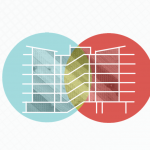By Cory Hollenhorst
Designers and architects are often met with the challenge of maintaining their design vision when building code requirements limit their ability to bring that vision to life. Such has been the case for decades with fire-rated doorways. A cohesive design plan, rich with wood doors and trim but subject to a fire rating, often forces the use of a metal frame, breaking up the intended appearance. While many professionals simply accept that as an unfortunate reality, innovations exist, some for many years now, that resolve the conflict between design intent and code requirements.
Fire-rated wood door frames aren’t new; 20-minute iterations have been widely available and used for decades, but the product category doesn’t end there. With a combination of specialty materials and manufacturing processes, real wood door frames can be created that rate 45, 60 and even as high as 90 minutes. For designers, architects, and other specifiers, this may be a revelation with some very positive impacts.
For years, hollow metal frames have been the default solution for higher-rated openings. This means that a well-designed opening, one that would benefit from the luxurious and warm appearance that only real wood can offer, has been subject to the institutional and rigid appearance of metal.
There are some solutions out there to hide the metal frames – cladding, trim kits, faux wood wraps, and fancy painting, but ultimately, when the look and feel of real wood is the design intent, real wood is the only option that will do. With fire-rated wood door frames, the design doesn’t have to be compromised.
So why don’t more professionals use fire rated wood door frames? Perhaps it is because they don’t know about them. They are not a flashy innovation. In a marketplace where new products often impress us with LED panels or wifi connectivity or some other “wow factor” enhancement, fire-rated wood door frames quietly solve a longstanding design problem, perhaps making them easy to miss. Their impact on design and functionality, however, may be as significant as any of the higher profile product innovations professionals come across.
Only a small number of manufacturers produce fire-rated wood frames. The manufacturing process is demanding as is the high level of customization the marketplace requires. Demand, however, has steadily increased since the product’s invention in the late 2000s.
The aesthetic advantage is clear, and designers value the ability to use real stain-grade or paint-grade wood to match doors, trim, paneling and other wood components in a design.
Fire-rated wood door frames can be configured multiple ways, but 45, 60 and 90-minute configurations will include intumescent material which is typically laminated into a substrate made of wood materials or gypsum. The wood-based laminated core typically installs like traditional interior wood jambs, nailed up with very little or no additional preparation. The gypsum-based cores require basic preparation, such as pre-drilling, but are similarly simple to install. This relatively easy installation process typically results in labor savings which help offset the higher cost of the frame itself.
In addition to aesthetic considerations, a strategic reason for the use of fire-rated wood frames is that the frames contain a sealing agent. This is a requirement in fire-rated openings that allows for the use of Category B doors. Without the sealing product in the frame, metal frames are used and Category A doors (which contain the sealant) are required. Category A doors are more expensive and offer fewer design options. Alternatively, peripheral sealing products can be added to the assembly, but this results in more labor, less aesthetic appeal, and potentially higher total costs per opening. A fire-rated wood door frame paired with a Category B door allows tremendous design flexibility while providing a cost-effective door unit.
Fire-rated wood frames are the ideal solution in many applications, but are particularly suited to multi-family buildings where occupants desire a truly “homey” feel. They also lend themselves well to assisted living and retirement residences or any other residential environment where hollow metal frames create an undesirable institutional feeling. Historic restoration projects also present opportunities where aesthetics are paramount but modern codes exist.
Other building types that have also seen increased demand include casinos, performing arts centers, theaters, libraries, churches, office buildings and anywhere else the luxurious look and feel of real wood enhances the design of a space.
With the growing demand for high-end condominiums and more stringent fire codes for multi-family construction, fire-rated wood door frames will continue to grow as a category. The challenge for the industry is to increase awareness of the available products so specifiers can include them at the initial planning phases.
As with all other matters of health and safety, there are strict standards to which the products must be manufactured. Manufacturers are happy to provide all of their rating information as well as product specifications and installation instructions, so consult with the manufacturer when you choose to specify their product.
With a huge range of available wood species, a multitude of configurations, and the appearance and durability that only real wood can offer, fire-rated wood door frames are a valuable product option for industry professionals with uncompromising design standards.
Cory Hollenhorst is the Director of Sales & Marketing for Ferche Millwork, manufacturer of FireRated Frames, wood door components and solid and veneered millwork. He can be reached at (320) 393-5777 or coryh@ferche.com.




















